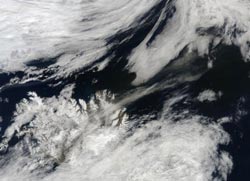NASA's Terra sees ash plume pulled to the northeast by a low

NASA\'s Terra satellite captured the ash plume from Eyjafjallajokull Volcano, Iceland, on May 18 at 12:20 UTC (8:20 a.m. EDT), blowing to the northeast due to a low pressure area. Credit: NASA Goddard / MODIS Rapid Response Team<br>
The brownish ash plume was being pushed to the northeast from a low pressure area situated to Iceland's northeast. The Moderate Resolution Imaging Spectroradiometer or MODIS instrument that flies aboard Terra captured an image on May 18 at 12:20 UTC (8:20 a.m. EDT).
NASA works with other agencies on using satellite observations to aid in the detection and monitoring of aviation hazards caused by volcanic ash. For more on this NASA program, visit: http://science.larc.nasa.gov/asap/research-ash.html.
As weather systems to continue to interact with the ash plume, it will continue to shift, so air travel may always be affected.
Media Contact
All latest news from the category: Earth Sciences
Earth Sciences (also referred to as Geosciences), which deals with basic issues surrounding our planet, plays a vital role in the area of energy and raw materials supply.
Earth Sciences comprises subjects such as geology, geography, geological informatics, paleontology, mineralogy, petrography, crystallography, geophysics, geodesy, glaciology, cartography, photogrammetry, meteorology and seismology, early-warning systems, earthquake research and polar research.
Newest articles

Properties of new materials for microchips
… can now be measured well. Reseachers of Delft University of Technology demonstrated measuring performance properties of ultrathin silicon membranes. Making ever smaller and more powerful chips requires new ultrathin…

Floating solar’s potential
… to support sustainable development by addressing climate, water, and energy goals holistically. A new study published this week in Nature Energy raises the potential for floating solar photovoltaics (FPV)…

Skyrmions move at record speeds
… a step towards the computing of the future. An international research team led by scientists from the CNRS1 has discovered that the magnetic nanobubbles2 known as skyrmions can be…




















